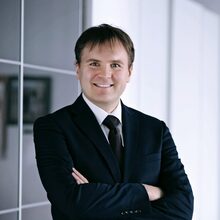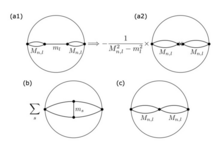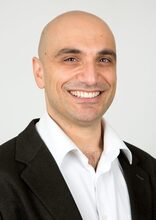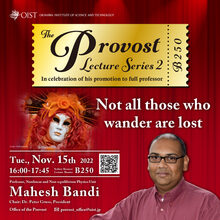Past Events
TSVP Teatime
"TSVP Teatime": informal discussions and getting to know each other
[Seminar] Determining ecosystem vulnerability through meta-analysis of empirical food webs
Prof. Karol Opara: Assistant professor at the Systems Research Institute, Polish Academy of Sciences, Poland
Creation of an isolated turbulent blob fed by vortex rings, Mr. Takumi Matsuzawa, The University of Chicago
Creation of an isolated turbulent blob fed by vortex rings, Mr. Takumi Matsuzawa, The University of Chicago. Language: English.
[Seminar] Climate change and cumulative impact in Arctic ecosystems
Prof. Raul Primicerio: Professor of Ecology and Evolutionary Biology at UiT, The Arctic University of Norway
"Successfully completing the final stretch – termination of DNA replication in bacteria" by Dr. Christian Rudolph
[Change of room: now L4F23 ]. Online seminar by Dr. Christian Rudolph from Brunel University London. Anyone interested is welcome. Zoom link and abstract in the description.
[Hybrid Seminar] "Towards Hierarchical Motor Control" by Dr. Steve Heim, Biomimetic Robotics Lab at MIT
"Towards Hierarchical Motor Control" by Dr. Steve Heim, Postdoc, Biomimetic Robotics Lab at MIT
Seminar "Universally superposing quantum operations toward quantum functional programming" by Prof. Mio Murao (Univ. of Tokyo)
Seminar by Mio Murao, Professor at Department of Physics, Graduate School of Science, Universty of Tokyo, Languate (English)
[Seminar] Temperate carbonate reefs, 'blue carbon' and the 'plastisphere'
This talk will introduce two major forms of cold-water biogenic habitats. Deep-sea coral reefs are extensive in the NE Atlantic region due to high food availability and high carbonate saturation levels. Maerl beds are calcified seaweed habitats and are the oldest biogenic habitat type found in shallow waters of the region. (...)
[Seminar] "Molecular Tools in Electrochemical Carbon Dioxide Reduction" by Dr. Orestes Rivada-Wheelaghan
Dr. Orestes Rivada-Wheelaghan, Ramón y Cajal Fellow, Instituto the Investigaciones Químicas (IIQ) at Universidad de Sevilla (Spain).Language: English
[Seminar] "Mechanoluminescence - smart visualization of dynamic mechanical behaviors toward innovative evaluation, design, and simulation" by Dr. Nao TERASAKI
Dr. Nao Terasaki, Team Leader, National Institute of Advanced Industrial Science and Technology (AIST). Language: English
OIST NetCafé (Online Information Session) in December 2022
This session will be done in Japanese. The program will start off with a general introduction of OIST, PhD & Research Internship admission process, financial support and student life followed by a panel discussion by two OIST PhD students.
Shaping the future of 3D interaction with virtual worlds by Dr. Anatole Lécuyer
Shaping the future of 3D interaction with virtual worlds
[Seminar] Prof. Wei-Hau Chang & Prof. I-Ping Tu, ACADEMIA SINICA
Speaker:
Professor Wei-Hau Chang, Institute of Chemistry, Academia Sinica, Taiwan
“Harnessing the power of Bertozzi reaction for capturing flexible parts in cryo-EM structures”
Speaker:
Professor I-Ping Tu, Institute of Statistical Science, Academia Sinica, Taiwan
" Garbage in, Einstein out A Mathematical Study of Einstein from Noise”
[Seminar] Sharp Uncertainty Principles and their stability, Professor Nguyen Lam, Memorial University of Newfoundland
Abstract: The Heisenberg uncertainty principle, which is a fundamental result in quantum mechanics, and related inequalities such as the hydrogen and Hardy uncertainty principles, belong to the family of geometric inequalities known as the Caffarelli-Kohn-Nirenberg inequalities. In this talk, we discuss some recent results about the optimal uncertainty principles, Caffarelli-Kohn-Nirenberg inequalities, and their quantitative stability. The talk is based on recent joint works with C. Cazacu, J. Flynn and G. Lu.
Uke Club Meeting - Seaside Lounge OR Beach!
With new songs! Probably!
[Seminar] Geometric PDE and Applied Analysis Seminar (12/1)
Talk 1: 15:00-16:00
Speaker: Prof. Shigeaki Koike (Waseda University)
Title: ABP maximum principle with upper contact sets for fully nonlinear elliptic PDEs
Talk 2: 16:00-17:00
Speaker: Prof. Michiaki Onodera (Tokyo Institute of Technology)
Title: A perturbation theory of overdetermined problems
Introduction to Intellectual Property
Curious about Intellectual Property? Please join our introductory seminar, hosted by TDIC alongside guest Patent Lawyer Gregory Kirsch.
This is an introduction-level seminar open to everyone at OIST.
"Polyelectrolytes with hydrophobic counterions: from fundamental physics to hand sanitisers"Carlos Gonzalez Lopez
Language: English
OIST/Humanoids2022 Joint Workshop
Neural Computation Unit will hold an OIST / Humanoids 2022 joint workshop at Auditorium. If you are interested in joining, please register.
QG group meeting - anomalous dimensions in HS holography
QG group meeting. Speaker: Yasha Neiman. Title: Locality of higher-spin gravity from anomalous dimensions of double-trace operators.
The Science of Safety: Understanding the Role of the Nervous System in Our Mental Health
We will take a closer look at the autonomic nervous system and the way our biology helps us navigate daily life, how we respond to cues of safety and danger below the level of conscious thought, and how this guides the way we move through the world, from turning toward and backing away, to connecting and other times isolating.
OIST Representation Theory Seminar
Seminar "Periodically driven sub-wavelength lattices" Prof. Gediminas Juzeliūnas, Vilnius University
Speaker: Prof. Gediminas Juzeliūnas, Vilnius University
FY22 _Fixed Asset Inspection session / 2022年度 固定資産実査説明会
FY22 _Fixed Asset Inspection session will be held via Zoom.Those in charge of please participate in this session.
Workshop on Life Mind Continuity
Workshop on Life Mind Continuity
The aim: We attempt to deepen understanding of mind through discussions of various issues including life mind continuity, theory of mind, embodied mind, phenomenal consciousness, alife and artificial intelligence.
Date: 1pm - 5:35pm, November 25th, 2022
Location: Room1, OIST Conference Center
Organized by Kazuo Okanoya, Takashi Ikegami, and Jun Tani
Seminar: “Deciphering genome evolution: protein fossils and complex rearrangements”, by Pr. Martin Frith.
Seminar from Pr. Martin Frith, Laboratory for Life Information decipherment (Center for Omics and Bioinformatics), Department of Computational Biology and Medical Sciences, Graduate School of Frontier Sciences, The University of Tokyo.
[Seminar] Martin Biehl: "Interpreting systems as solving POMDPs: a step towards a formal understanding of agency"
Interpreting systems as solving POMDPs: a step towards a formal understanding of agency.
Martin Biehl, senior research scientist at Cross Labs.
[Seminar] Christian Guckelsberger: "Four projects on Intrinsic Motivation, Embodiment, Creativity & Videogames"
Four projects on Intrinsic Motivation, Embodiment, Creativity & Videogames.
Christian Guckelsberger, Computer Scientist, Art Historian and Assistant Professor in Creative Technologies at Aalto University.
Okinawa Christian School International (OCSI) open house registration open
Okinawa Christian School International (OCSI) will hold their Open House for prospective families on November 23rd, 2022. Events like this tend to fill up quickly, so if it is a school you are interested in for your children, I recommend you register early.
Collective Intelligence in Living/Non-Livings Populations
"Collective Intelligence in Living/Non-Livings Populations" Workshop 2022. Language: English (no interpretation). Target audience: Invited Guests.
Seminar: "The Truesdell Rate in Continuum Mechanics". by Prof. Salvatore Federico
Speaker: Prof. Salvatore Federico
A faculty member in the Department of Mechanical and Manufacturing Engineering and the Department of Biomedical Engineering (2008-present), with an adjunct position in Kinesiology, Human Performance Laboratory (2012-present)
Title: "The Truesdell Rate in Continuum Mechanics"
Marine genomics seminar #39: “Once we were worms: The origin of gills, skeletal ossicles & tubes in the deuterostomes” by Dr. Christopher B. Cameron
Christopher Cameron is a Professor in the Department of Biological Sciences at University of Montreal.
[Seminar] Nathaniel Virgo: "What is an agent?"
What is an agent?
Nathaniel Virgo, Associate Professor at Earth-Life Science Insitute (ELSI) in Tokyo.
Perovskite/Si tandem solar cells with 30% efficiency
Speaker: Dr. Lars Korte
Helmholtz-Zentrum Berlin für Materialien und Energie, Germany Humboldt Universität zu Berlin, Germany Technische Universität Berlin, Germany
Meet the Innovation Supporters at OIST - free coffee and snacks
Join the staff of the Technology Development & Innovation Center for free coffee and snacks and ask them how OIST can help support innovative ideas, prototyping, starting a business, and more. Come any time between 3 pm-4 pm and bring your coffee cup, mask, and boundless curiosity.
Accelerating Biomedical Science Innovation, featuring Dr. Tanja Rosenmund
The OIST Innovators Society is hosting a fireside chat on accelerating biomedical science innovation, featuring Dr. Tanja Rosenmund, Visiting Researcher at OIST and Director of SPARK Berlin Institute of Health . The event will be followed by an open house with staff of the Technology Development & Innovation Center and free coffee and snacks!
Orators Meeting for Communication & Public Speaking
OIST Orators meet every two weeks to practice public speaking. No matter your level or experience, everyone is welcome to come and learn together! Our meetings typically consist of prepared talks, impromptu topics to practice speaking on the spot, and a short seminar on some aspect of oratory.
[Seminar] Poincare inequalities on the Vicsek set, Professor Chen Li, Louisiana State University
Abstract:
The Vicsek set is a tree-like fractal on which neither analog of curvature nor differential structure exists, whereas the heat kernel satisfies sub-Gaussian estimates. I will talk about Sobolev spaces and scale invariant $L^p$ Poincar\'e inequalities on the Vicsek set. Several approaches will be discussed, including the metric approach of Korevaar-Schoen and the approach by limit approximation of discrete p-energies.
Zoom : https://oist.zoom.us/meeting/register/tJEpdu-uqTwrGdFV5IrA0woMhvhlxVa_5ttw
Startup Pitch Competition: Global Entrepreneurship Week
Watch entrepreneurs battle it out at the OIST Startup Pitch Competition and cast your vote for the "Audience Choice Award". Free coffee and snacks.
Thursday, November 17, 2022 1:30pm-3:00pm Center Building, C209
[Seminar] "Prediction with expert advice: a PDE perspective on a model problem from machine learning" by Prof. Robert V. Kohn
Speaker: Prof. Robert V. Kohn (Courant Institute of Mathematical Sciences, NYU)
Title: Prediction with expert advice: a PDE perspective on a model problem from machine learning
[Seminar] Community assembly and species coexistence in the heterogeneous world
Dr. Naoto Shinohara, Specially appointed assistant professor, Tohoku University.
Language: English, no interpretation. All are welcome to attend.
<Seminar> Prof. Berkhout, HIV keeps on surprising us: a CRISPR-Cas cure adventure and a drug-resistance story
Title: HIV keeps on surprising us: a CRISPR-Cas cure adventure and a drug-resistance story
By Dr. Ben Berkhout, University of Amsterdam.
Language: English, no interpretation
OIST Representation Theory Seminar
The Provost Lecture Series 2
【Seminar】SKP1A links Polycomb-repressed genes with proteasome
Yamamoto Unit presents a seminar by Dr. Haruhiko Koseki, Deputy director and team leader, Center for Integrative Medical Sciences, RIKEN. The seminar is about Polycomb, PRC1, SKP1A, proteasome, CGI.
Seminar "Unitary few- and many-body problems in ultracold Fermi gases" Prof. Shimpei Endo, Tohoku University
Speaker: Prof. Shimpei Endo, Tohoku University
Uke Club Meeting - Seaside Lounge OR Beach!
We've been missing you ukulately!
International Schooling Options Information Seminar 2022 インターナショナルスクール説明会
2022 International Schooling Options Information Seminar - a hybrid event featuring representatives from 6 international schools. Open to OIST community, including parents, carers, and curious people.
Thursday, November 10th, 2022
18:00-20:00
B250 and Zoom
See flier for more details and to register














































